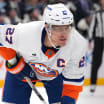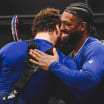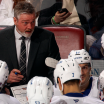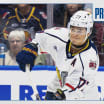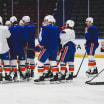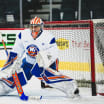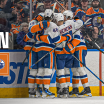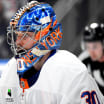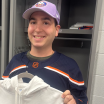Now you see him, now you don't.
That, in a sense, could sum up Pierre Turgeon's Islanders career -- punctuated by precision goals, adroitly-contrived assists and adulation galore.
The French-Canadian center's deft maneuvers were seen by hordes of enemy defensemen and -- whoops! -- he would disappear around them; either setting up a goal or illuminating the red light by himself.
Maven's Memories: Terrific Pierre Turgeon
Stan Fischler profiles prolific scorer and gentleman Pierre Turgeon
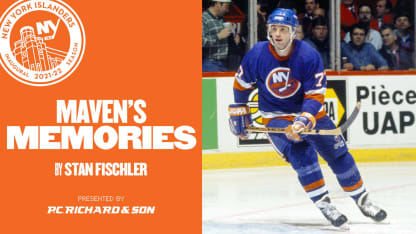
By
Stan Fischler
Special to NHL.com
"Pierre was a pleasure to watch," said GM Bill Torrey, "whether you were looking for a big goal or for someone -- meaning him -- to set up a key score. I was glad we were able to get him when we did."
The trade proved to be one of the most impactful in NHL history because of the Grade-A talent involved as well as the number of bodies exchanged.
Torrey dispatched Pat LaFontaine to Buffalo along with forward Randy Wood and defenseman Randy Hiller.
In return the Nassaumen obtained Turgeon as well as forwards Benoit Hogue and Dave McLlwain and defenseman Uwe Krupp.
Torrey: "I had to give up talent to get talent but the important thing was that the time had come for me to change the team's look."
earlier today, Pierre Turgeon joined @TheHaileyHunter at the desk to discuss his playing days, #Isles Alumni Weekend and more! pic.twitter.com/u3D8EqLI8b
— New York Islanders (@NYIslanders) April 24, 2022
The chief protagonists -- Turgeon and LaFontaine -- could not have been more different in both playing style and hockey roots.
A French-Canadian, Turgeon hailed from Rouyn-Noranda, Quebec while the American-born LaFontaine honed his hockey skills to sharpness playing his early hockey in the Detroit area.
Patty's game relied on a blend of speed and extraordinary playmaking ability whereas the bigger Turgeon displayed the same grace, marksmanship and scoring techniques of a Jean Beliveau.
While LaFontaine was an instant fan favorite -- a terrific interview by the way -- Turgeon was amiable enough, but more introverted.
For coach Al Arbour, Turgeon's arrival proved to be a tonic in many ways, on and off the ice.
"Pierre certainly had a style all his own," said Arbour. "At times it was stealthy and especially potent. Let's not forget that he had big skates to fill considering how important Patty had been to our offense."
Hints of some kind of explosive trade had been in the works for some time. One could point to a disappointing 1990-91 Isles season as the catalyst for Bow Tie Bill to put his roster in a mixmaster and then turn on the switch.
"I assume responsibility for the product," the GM candidly commented during the summer of 1991. "This team obviously must be recycled."
In LaFontaine and captain Brent Sutter, Torrey had two valuable bargaining chips to cash and change the face of the franchise. Rumblings of discontent drew louder at training camp, September 1991.
Arbour wanted LaFontaine to be the club's centerpiece but the All-Star center rejected Torrey's four-year contract offer. When the lithe scorer walked out of camp, and demanded a trade, it was clear that a deal would be made.
D -- as in Deal -- Day turned out to be October 25, 1991. The magnitude of the deal sent tremors around the league.
"It's clear,." said one veteran reporter, "that Torrey is re-inventing his team with character and depth."
Although Turgeon needed time to adjust to his new surroundings, he enjoyed instant success averaging more than a point a game -- three goals and four assists --in his first five contests with his new squad.
Inside Islanders Alumni Weekend
Arbour eventually paired (center) Turgeon with wingman Derek King. Prior to being aligned with Turgeon, Derek had been an up-and-down player, but Pierre did wonders for his buddy.
On March 27, 1992, King and Turgeon each scored their 40th goals at Maple Leaf Gardens in a 6-2 win over Toronto. But the best was yet to come.
"I wanted to keep Turgeon and King together." said Arbour, "so the question was about who should be third man on the line."
The coach chose squat Steve Thomas who had a giddy-ap skating style which led him to bop opponents as often as a pinball would bounce off a flipper. Stevie's shot was deadly accurate.
"We had a nice balance up front," Turgeon recalled. "Al could put our line out there and also feel good about the other two combinations."
Apart from the always reliable veteran Patrick Flatley, there were the likes of slick-passing Ray Ferraro, speedy Benny Hogue, native New Yorker Brian Mullen; not to mention swingmen Marty McInnis and David Volek.
"We also had some good defensive forwards," Turgeon added, "and a solid penalty-killing unit."
Claude Loiselle and Tom Fitzgerald were the premier PK artists while "police" work was handled by Mick Vukota and Brad Dalgarno.
On paper, the roster held promise but as the 1992-93 season unfolded, the on-ice product was less than formidable.
Turgeon: "By the middle of November (1992) Flats figured it was time to call a players' meeting and straighten out a few things that were not working smoothly."
Slowly but surely, the team got on track. Rookie defensemen Darius Kasparaitis and Vladimir Malakhov proved to be a better-than-average one-two combination and Glenn Healy looked good in goal.
And then there was Turgeon who received good reviews wherever he skated and in print well. In "Pride And Passion," the 25-year history of the Islanders, Lucky Pierre received the highest praise.
Alumni Classic Highlights
"The graceful French-Canadian star brought a sense of poise to his teammates on the ice, even though he was not a vocal leader in the dressing room.
There were games when Turgeon was absolutely dominant, seemingly carrying the club single-handedly to wins."
Media types suggested that Pierre was a Hart (MVP) Trophy candidate and also his ever-clean play could earn him the Lady Byng Trophy. (He did win the Byng.) Ever-taciturn, Turgeon just played hard and talked little.
"He doesn't know how good he is," said linemate Steve Thomas, "so when I have the chance, I remind him."
More and more, the LaFontaine trade proved a plus for the Islanders. In addition to Turgeon's histrionics, Hogue had developed into an offensive asset.
"Hogue was second to Turgeon in terms of value for the entire season," noted the team's quarter-century history.
Krupp was no slouch either and as the NHL schedule reached the homestretch in March 1993, the Islanders found themselves in a dogfight for the final three Patrick Division playoff spots along with the Rangers, Devils and Capitals.
In one of the most important games of his career, Turgeon delivered the winning goal against the Rangers on April, 2 at The Garden.
The goal -- Pierre's 50th of the season -- moved the Islanders closer to a playoff berth while torpedoing the Blueshirts chances.
On the final night of the season the Isles beat New Jersey and Lucky Pierre added an ooh-la-la to the campaign with another hat trick in the 8-4 decision.
Now it was on to the playoffs and the Nassaumen drew Washington in the first round. In the Isles 25-year-history, the series was portrayed as a war game on ice. To wit:
"It's a showdown between two hard-working cubs that were going to kill each other for the right to be led to the slaughter by the (two-time Cup-winning) Penguins."
There would be no letdown to the big buildup. The series evolved into one filled with tension and blood.
With the series tied at one win apiece, the pivotal Game Three looked like it would go to Washington. But the Isles overcame a 3-1 deficit when Turgeon pulled the team even with the game-tying tally with 42.7 seconds left in regulation.
"Thank you very much, Pierre," said Ray Ferraro who potted the winner in the first sudden-death period.
The series wound down to a Game Six at the Coliseum with the Isles up three games to two. It was all Islanders thanks to goals by Thomas, Hogue -- a shorthander -- Dalgarno, Travis Green and, finally, Turgeon.
But the joy was sucked out of the triumph in the seconds after Pierre had scored his team's final goal. As Turgeon raised his arms in triumph, he was blindsided by Washington's Dale Hunter.
The vicious cheap shot sent Turgeon to the ice suffering from what would be a third-degree shoulder separation. Hunter's gratuitous clout was one of the most dastardly acts this observer has even seen.
New NHL Commissioner Gary Bettman hit Hunter with the stiffest penalty then allowed by league rules -- a 21 -game suspension. Bettman summed up the hockey world's feelings with these words:
"No punishment can undo Hunter's actions or erase the competitive loss to the Islanders."
Still, Al Arbour's dauntless skaters engaged the two-time Cup champion Penguins in the next round. Inspired at least in part by the Turgeon episode, New York spectacularly won the series with a Game Seven overtime win on a David Volek slapshot.
It was on to Montreal where, in Game Two, of the third round, Turgeon returned and scored the first goal of the game. But it was not enough for a weary team.
The Canadiens would win the series and, in due time, Pierre would fully recover. He returned for the 1993-94 season and played 69 games good for 94 points.
Still L'Affaire Hunter continued to cast a pall over Pierre's Islander career. Finally, during the following campaign he was dealt to Montreal.
All things considered, Turgeon gave his all for the Nassaumen. Were it not for Hunter's despicable act, who knows what glorious feats this flying Frenchman would have accomplished for the franchise.
Looking backward, we can only say that Pierre made it fun while he lasted.

